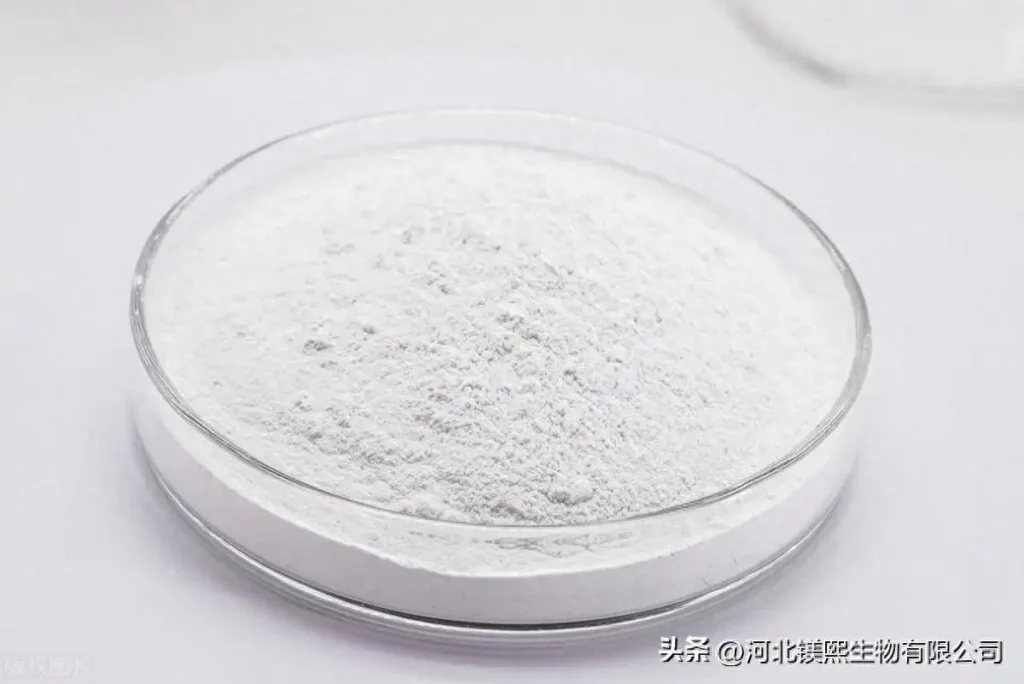Hebei Messi Biology Co., Ltd. stated that domestically, the carbonation of carbon dioxide is used to react with magnesium hydroxide aqueous solution to generate needle-shaped MgCO3·3H2O crystals. The impact of the addition amount and temperature of alkaline solution sodium hydroxide on the crystal form was focused on. Alternatively, carbon dioxide is introduced into the suspension of magnesium hydroxide and the temperature is raised to produce different magnesium carbonate whiskers and basic magnesium carbonate. The effects of reaction temperature, pH value and hydrochloric acid were investigated, and the products were confirmed and thermally analyzed using XRD and TG/DTA.
There are relatively many domestic studies on the preparation of magnesium carbonate whiskers from magnesium bicarbonate aqueous solution. Add an appropriate amount of additives to the magnesium carbonate solution and control the crystallization conditions of magnesium carbonate to obtain magnesium carbonate whiskers of different specifications, with diameters of 0.1 μm to 5 μm and lengths of 20 μm to 2000 μm. They believe that the molecular formula of the synthetic product is MgCO3・nH2O, where n=1~5. Mix the saturated solution of magnesium chloride and ammonium bicarbonate at a molar ratio of 2:1, add the surfactant polyvinyl alcohol (accounting for 1% of the total system mass), raise the temperature to 60°C with stirring, and react for 40 minutes to obtain The slurry was filtered and washed with deionized water until no chloride ions were detected in the washing liquid (using silver nitrate). The washed filter cake was vacuum dried at 60°C for 4 hours to obtain magnesium carbonate whiskers.

Low-grade magnesite was used to obtain heavy magnesium water through hydration and carbonation, and then the heavy magnesium water was pyrolyzed at 50°C to produce magnesium carbonate. The influence of pyrolysis conditions on the crystal morphology of the pyrolysis product magnesium carbonate was studied. The results show that the pyrolysis product is MgCO3·3H2O. When the additive is potassium dihydrogen phosphate, petal-shaped magnesium carbonate is prepared; when the additive is ammonium carbonate, spherical magnesium carbonate is prepared; when the additive is soluble magnesium salt, magnesium carbonate whiskers are prepared. As the stirring intensity increases, the aspect ratio of the product first increases and then decreases. When soluble magnesium salt is added, the pyrolysis temperature is 50°C, and the stirring intensity is 200r/min, magnesium carbonate whiskers with a length of 10μm~40μm and an aspect ratio of 10~20 can be obtained.
Magnesium oxide is obtained by calcining magnesite, carbon dioxide is introduced into the magnesium oxide suspension, magnesium bicarbonate is produced using KH₂PO4 as an additive, and then the temperature is pyrolyzed to obtain magnesium carbonate whiskers. The effect of the additive content and stirring speed on The influence of whisker morphology and aspect ratio. Calculate magnesite at 850℃ to obtain magnesium oxide, add deionized water to prepare a suspension, add carbon dioxide to obtain magnesium bicarbonate, heat to 40℃~80℃, add different additives, and pyrolyze to obtain magnesium carbonate. After drying, magnesium oxide whiskers are obtained.
Using low-grade magnesite as raw material, it is lightly burned and carbonated under different conditions. The slurry is converted into magnesium bicarbonate and enters the liquid phase to produce heavy magnesia water. Activated carbon is used as the adsorbent to remove calcium, iron, etc. impurities, and the effects of different additives on the morphology of heavy magnesium hydropyrolysis products were studied. When there is no additive, the pyrolysis product is in the form of flakes; when the acidic additive potassium dihydrogen phosphate is added, the pyrolysis product is in the shape of petals; when the alkaline additive ammonium carbonate is added, the pyrolysis product is in the shape of a ball; when soluble magnesium salt is added, the pyrolysis product is in the shape of a petal. It is whisker-shaped.
Using MgCl2・6H2O and NH4HCO3 as raw materials and Na2HPO4 as surfactant, magnesium carbonate trihydrate whiskers were synthesized using a low-temperature aqueous solution method. The maximum influence of factors such as reaction temperature, reaction time, and surfactant dosage on magnesium carbonate trihydrate whiskers were investigated. Effect of whisker length and aspect ratio. The results show that micron-sized magnesium carbonate trihydrate whisker products can be synthesized under the conditions of reaction temperature of 40℃~50℃, reaction time of 50min~60min, and surfactant addition amount of 1%. On this basis, the growth mechanism of magnesium carbonate trihydrate whiskers was discussed.
Using low-temperature hydrothermal synthesis as a means, MgSO4·7H2O and NHHCO3 as raw materials were used to prepare magnesium carbonate trihydrate whiskers. The effect of reaction temperature on the preparation of magnesium carbonate trihydrate whiskers was investigated, and the best method for preparing magnesium carbonate trihydrate whiskers was determined. The temperature is 50°C, the average length is 247 μm, and the average diameter is 7.2 μm.
Hebei Messi Biology Co., Ltd. stated that the synthesis of magnesium carbonate in aqueous solution will undergo a series of phase transfer processes. The thermodynamic stability of different crystal forms is the basic driving force for phase transfer. The transformation process is a kinetic process and different thermodynamic conditions There is a corresponding relationship between the degree of downward transformation and time. The process of preparing magnesium carbonate whiskers by pyrolysis either requires timely introduction of carbon dioxide or surface additives, which increases operating costs and process complexity. The co-precipitation process is easy to control, and the magnesium carbonate whiskers formed have high purity.

Comments are closed.